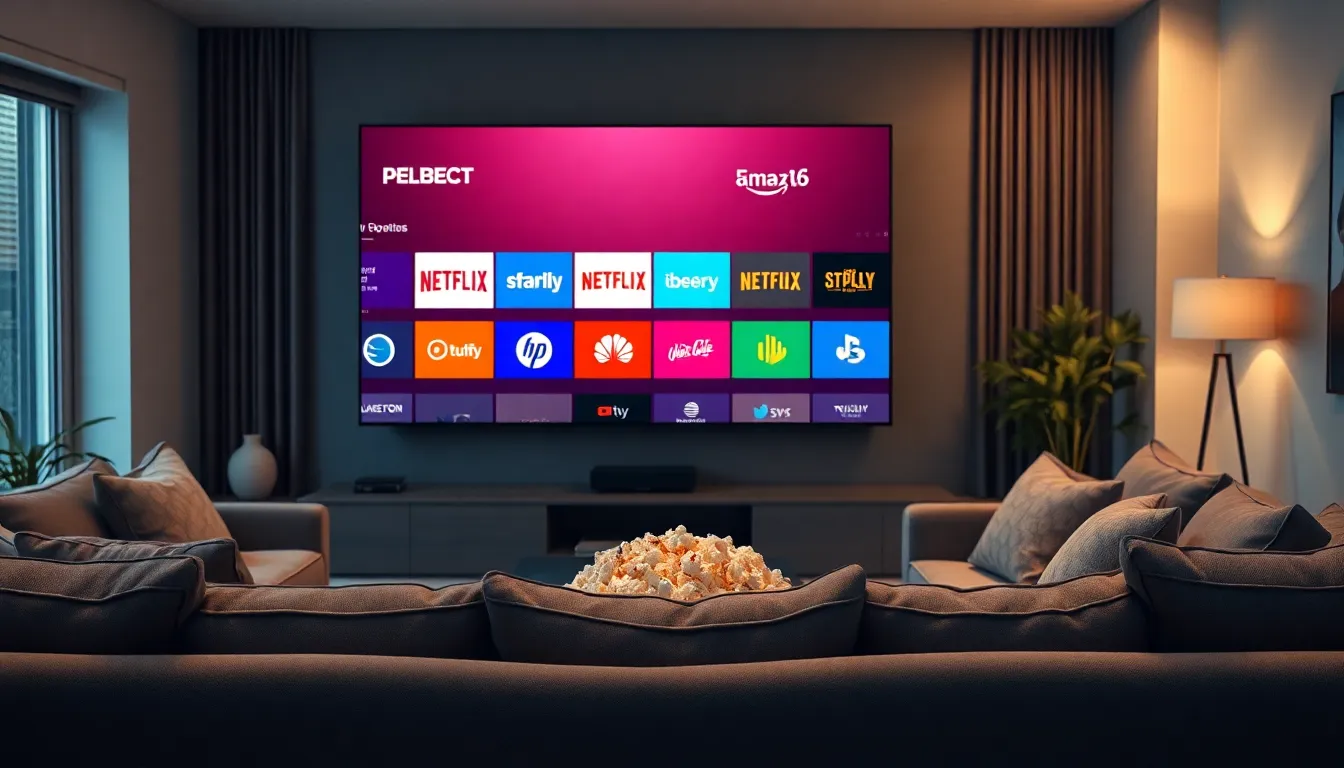The streaming landscape is evolving at a breakneck pace, reshaping how audiences consume entertainment. With the rise of platforms like Netflix, Hulu, and Disney+, viewers now have unprecedented access to a vast array of content. This shift isn’t just about convenience; it’s transforming the entire industry, influencing production, marketing, and even the way stories are told.
As technology advances, so do consumer preferences. From binge-watching to live streaming events, trends are emerging that reflect a new era of engagement. Understanding these trends is crucial for content creators and marketers alike, as they navigate this dynamic environment. By keeping an eye on what’s popular, they can better cater to audiences and stay ahead in the competitive streaming game.
Table of Contents
ToggleCurrent Streaming Trends
Streaming content consumption continues to evolve, influenced by various factors. Notable trends currently shaping the industry include:
- Binge-Watching Behavior: Audiences prefer consuming entire seasons at once. Research shows that 70% of viewers binge-watch series, leading platforms to release full seasons to cater to this demand.
- Live Streaming Events: Popularity for live content, such as sports and concerts, has surged. According to a study by Statista, live streaming events attract 80% of online viewers, providing businesses with unique marketing opportunities.
- Short-Form Content: Platforms like TikTok and Instagram Reels showcase the shift towards concise content. They demonstrate that 15 to 60-second videos engage viewers effectively, aligning with the modern audience’s preference for quick consumption.
- Increased Mobile Viewing: Mobile devices account for 60% of streaming sessions, driven by accessibility and convenience. Content creators optimize their productions for mobile screens, ensuring quality and engagement across devices.
- Subscription Fatigue: As more streaming services emerge, consumers face subscription overload. A recent survey indicates that 30% of users intend to reduce their subscriptions, compelling providers to offer more competitive pricing and bundle options.
- Personalization in Content: Streaming platforms leverage algorithms to enhance user experience. Customized recommendations are found to increase viewer satisfaction by 40%, ensuring content resonates with individual preferences.
- Diverse Content Offerings: Diverse programming, including international films and niche genres, sees growing support. With 60% of viewers seeking multicultural narratives, platforms expand their libraries to include varied content.
These trends illustrate how streaming services adapt to meet audience expectations and preferences, significantly shaping the future of entertainment consumption.
Popular Streaming Platforms

Streaming platforms play a pivotal role in shaping entertainment consumption. Each platform offers unique features and content to engage diverse audiences.
Netflix
Netflix remains a leader in the streaming industry, boasting over 230 million subscribers globally. Its extensive library includes original series, films, and documentaries that cater to various tastes. Recent trends show a shift towards greater investment in interactive content, enabling viewers to influence storylines. Additionally, Netflix’s global approach ensures localized content for international markets, increasing its appeal. The platform’s strategy includes regular updates to algorithms that enhance personalized viewing experiences, further solidifying its dominance.
Hulu
Hulu offers a blend of on-demand and live TV, attracting approximately 48 million subscribers. Its strength lies in providing current episodes of popular series shortly after airing, making it a favorite among viewers who seek timely content. Hulu also focuses on original programming, with acclaimed series that draw significant attention. The platform’s bundling options with Disney+ and ESPN+ enhance its competitiveness by offering a comprehensive entertainment package, meeting diverse viewing preferences.
Disney+
Disney+ rapidly gained traction since its launch, currently boasting over 150 million subscribers. The platform’s appeal centers on its vast catalog of family-friendly content, including classic Disney films and franchises like Marvel and Star Wars. Exclusive original series and films have enriched its offerings, drawing loyal fans. Disney+’s strategy emphasizes a combination of nostalgia and new content, targeting both long-time Disney fans and younger audiences. Regular updates engage subscribers, maintaining interest and viewership loyalty in a competitive market.
Content Consumption Patterns
Content consumption patterns are evolving rapidly in the streaming landscape, driven by viewer preferences and technological advancements.
Binge-Watching Habits
Binge-watching dominates viewing behavior, with 70% of viewers opting to consume entire seasons at once. Platforms now often release full seasons to cater to this demand, emphasizing user engagement and experience. This trend has shifted production strategies, encouraging creators to design narratives that sustain viewer interest across multiple episodes. As a result, storytelling techniques are adapting to leverage cliffhangers and interconnected plots, enhancing the binge-watching experience and retaining audiences for longer periods.
Short-Form Content
Short-form content is on the rise, particularly on platforms like TikTok and Instagram Reels, where quick videos attract significant viewership. This format resonates with users’ preferences for concise entertainment, facilitating rapid consumption habits. As audiences gravitate towards shorter content, streaming platforms are beginning to incorporate brief clips and highlight reels, appealing to viewers looking for instant gratification. This shift pushes creators to balance quality storytelling with brevity, ultimately expanding their reach and engagement in a crowded digital landscape.
Impact of Streaming on Traditional Media
Streaming’s rapid rise has profoundly affected traditional media outlets, altering their operational strategies and audience engagement approaches. Viewership migration to streaming platforms has decreased broadcast television ratings by 24% since 2015. This ongoing shift has pressured traditional networks to adapt their delivery methods and content offerings to retain viewers.
Advertising revenues for traditional media have declined due to the growing preference for ad-free streaming experiences. Research indicates a 15% drop in ad spending on network television, prompting these networks to explore new revenue models, including subscription services and partnerships with streaming platforms. Traditional media now often incorporates streaming-like features, such as on-demand content accessibility and exclusive online releases.
Content production has also transformed. Traditional media has adapted its storytelling techniques to align with streaming standards, producing shorter series and mini-series. These formats cater to binge-watching behaviors and seek to engage audiences quickly. Viewers now expect high-quality visuals and well-crafted narratives, akin to those found on premium streaming platforms.
Moreover, traditional media companies are investing heavily in their own streaming services. Major networks like NBCUniversal have launched Peacock, and WarnerMedia introduced HBO Max to compete against established platforms. These initiatives illustrate how traditional media outlets strive to maintain relevance in a landscape increasingly dominated by streaming.
Further changes stem from partnerships and collaborations between traditional and streaming platforms. Content sharing agreements allow traditional networks to reach broader audiences while streaming services benefit from established franchises. This synergy enhances content diversity, satisfying audience demand for varied programming.
Overall, the transformation of the traditional media landscape illustrates an adaptive response to the growing influence of streaming, reshaping the future of content consumption.
Future Predictions for Streaming Trends
Emerging trends indicate significant changes in streaming, shaping audience behavior and platform strategies.
- Growth of Ad-Supported Models: Ad-supported streaming services are projected to attract a broader audience. As subscription fatigue rises, 45% of users express interest in cost-effective, ad-supported options. This model allows viewers to access content without the financial burden of multiple subscriptions.
- Expansion of Interactive Content: Platforms are increasingly focusing on interactive and user-generated content. Following Netflix’s success with interactive shows, nearly 30% of streaming services plan to develop similar offerings, engaging viewers more deeply in storytelling.
- Virtual Reality Integration: The incorporation of virtual reality (VR) is anticipated to enhance viewer experiences. Content that allows immersive exploration might attract 35% of audiences, providing a new dimension to storytelling and interactive viewing.
- Personalized Content Experiences: Enhanced personalization through advanced algorithms will dominate the streaming landscape. Predictions indicate that personalized recommendations could improve viewer engagement by 50%, making content discovery easier and more tailored.
- Short-Form Content Dominance: A continued shift toward short-form content is expected as platforms acknowledge changing audience preferences. By 2025, 60% of streaming platforms might prioritize bite-sized content, aligning with users’ consumption habits.
- Diversity in Content: Demand for diverse narratives will drive content creation. Industry insights show that by 2024, 70% of viewers seek multicultural stories, pushing platforms to diversify their offerings significantly.
- Hybrid Models: The blending of on-demand and live content will gain traction. Anticipated growth in hybrid service models will cater to diverse audience needs, ensuring viewers can enjoy both immediate access to shows and live events.
- Increased Focus on Regional Content: As global competition intensifies, streaming services will invest more in regional content. Projects suggest that local language programming could see a 40% increase, addressing the tastes of global audiences.
These forecasts signal an evolving landscape where streaming services adapt to viewer demands, creating innovative and immersive entertainment experiences.
The streaming landscape continues to transform at a rapid pace. As platforms adapt to viewer preferences and behaviors, the future of entertainment consumption looks promising. With the rise of ad-supported models and interactive content, audiences can expect more diverse and engaging experiences.
Short-form content is likely to dominate, catering to the need for quick consumption. Additionally, the growing demand for multicultural narratives will push platforms to expand their offerings. As streaming services innovate and evolve, they’ll shape not just how content is consumed but also how stories are told, ensuring a dynamic and exciting future for both creators and viewers.



